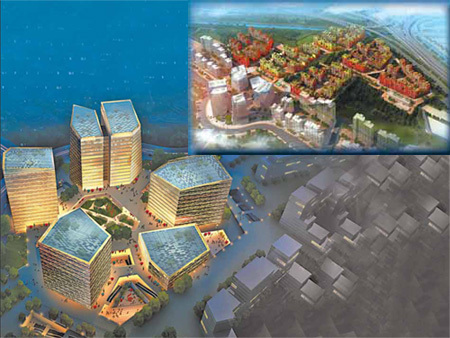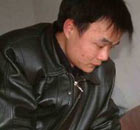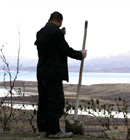AREP
Hangzhou's Qibao Complex: a vision of life in the future
By Wang Danna (China Daily)
Updated: 2009-12-22 07:52
 |
Large Medium Small |
|
A panoramic view of the Hanghzou Qibao Complex, which is started this year and will be completed in about three years wtih a total construction area of 1.03 million sq m and a total investment of 3.3 billion yuan. |
One day in my life of 2015 might start like this - In the morning I will send my baby to the kindergarten located within the apartment community and then drive my car to Jianhua road, which provides access to the Hangzhou business center and the company I work for.
In the evening I will meet one or two of my friends for supper or for business in the commercial area or in the hotels and office buildings near the metro, Hangzhou's Qibao Depot (Jianhua Station).
After that we will go shopping in the block's shopping malls. When finish, I will drive across the ramp, which links the residential community with other parts of the block above the city's metro yard.
Yes, that will be typical of my life after I move to the block above Hangzhou Qibao Metro Depot (Jianhua Station), which is a highly convenient setting, integrating all of the factors that constitute daily life, including education, business, entertainment, shopping and public services.
What I describe above is my vision of future life when the Hangzhou Qibao Metro Depot Development project is completed in two or three years time. It is also the result of a talk with Tang Jun, general architect, and Fleur des Digures, director general of AREP China.
Designed by France-based AREP, a multi-disciplinary architecture and town planning design firm wholly owned by the French government and launched in January 1997, the block is located in Hangzhou's northeast quarter and connected to the Desheng road to the north, Beitang Zhonglu to the west and Jianhua road to the southeast.
The whole block is set above the Jianhua subway station, which is one of the best examples of its kind in the world. Another example of a similar project is Paris's Montparnasse, on the left bank of the River Seine, another masterpiece devised by AREP.
Addressing the design and concept of the block, Tang said the designer, Etiene Tricaud, general manager and architectural engineer of AREP, with a noted penchant for things Chinoise, planned a "Seven Diamond" - seven main sections - for the residential community, which coincides with the subway's Chinese name "Qi Bao", which has the same meaning in Chinese. Tang has contributed to building a bridge between the design concepts of the projects for French and Chinese architects.
Tang told me the idea of the internal courtyard for the residential community came from the Chinese architectural style known as 'Siheyuan', one that was traditionally adopted for courtyard houses. He said that Chinese people like this particular style as Siheyuan looks like a closed architecture from the outside, but provides an open space for the people living in the courtyard.
One of the main residential community internal roads is called the "Valley", this is a place where people and vehicles enjoy their own space surrounded by plentiful green land. It is a good interpretation of the designer's concept of ensuring the land use is completely in keeping with its surroundings.
With all-around facilities, including green spaces, apartments and residential communities, education, commercial and services apartments, offices and hotels, police and fire stations, the block is extremely well planned, presenting a coherent functional design concept of a radiant layout corresponding to the site and creating an impressive landscape.
The green slopes and housing blocks in the north and the continuous urban facade in the south create a harmonious street view with a distinct urban rhythm. The green slope, which connects to the city's road network is a ground level, combined with slab above the metro, some nine meters higher, it will create an impressive spectacle.
As the whole world is advocating a low-carbon lifestyle and economy, the designers of the block have not neglected this requirement when developing their overall masterplan, said Tang.
It is small wonder that Tang is one of the leading experts in his area. He is extremely vocal when commenting on the design details of this ecological architectural complex. The designers have made ample consideration for the drainage system, damping system and noise reduction requirement. For example, they use a spring for the structural column and a vertical well for drainage. All of the buildings are designed to withstand earthquake intensity of level six.
One of the most difficult aspects of design concerns the structural column as it is bearing the load of all the buildings above the metro. The problem was solved through several insightful solutions. Most of the structures above the metro are parallel with the subway line and no heavy buildings but green lands are immediately above the "Throat" (the rail bifurcation points) which proved an excellent solution to the bearing problem.
It was the perfect design and concepts of the AREP team that won it the chance to work on the project of urban and conceptual design of the Hangzhou Qibao Complex back in April, construction work on the project to begin later this month. The short period of the whole process - from the bidding to implantation - is an appropriate reflection of China's social development, according to Fleur des Digures.
(China Daily 12/22/2009 page12)








